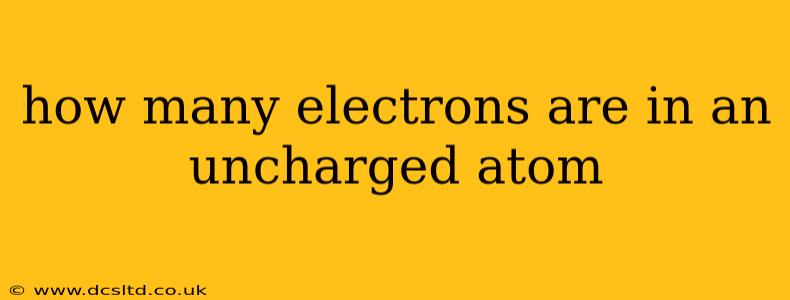How Many Electrons Are in an Uncharged Atom?
The number of electrons in an uncharged atom is always equal to the number of protons in its nucleus. This fundamental principle is crucial to understanding atomic structure and chemistry. Let's delve deeper into this concept.
Understanding Atomic Structure:
Atoms are the basic building blocks of matter. They consist of three primary subatomic particles:
- Protons: Positively charged particles located in the atom's nucleus.
- Neutrons: Neutrally charged particles also found in the nucleus.
- Electrons: Negatively charged particles orbiting the nucleus in electron shells or energy levels.
The atomic number of an element defines the number of protons in its nucleus. Since an uncharged atom has no net electrical charge, the number of positively charged protons must be balanced by an equal number of negatively charged electrons. This ensures electrical neutrality.
Example:
Consider a carbon atom (C). Carbon has an atomic number of 6, meaning it possesses 6 protons in its nucleus. Therefore, a neutral carbon atom also contains 6 electrons.
Ions and Charged Atoms:
It's important to note that this relationship holds true only for uncharged atoms. When an atom gains or loses electrons, it becomes an ion, acquiring a net positive or negative charge.
- Cation: A positively charged ion formed when an atom loses electrons. The number of electrons is less than the number of protons.
- Anion: A negatively charged ion formed when an atom gains electrons. The number of electrons is greater than the number of protons.
How to Determine the Number of Electrons in an Uncharged Atom?
Simply find the atomic number of the element on the periodic table. That number directly corresponds to the number of protons and, consequently, the number of electrons in an uncharged atom of that element.
What Determines the Number of Electrons in an Atom's Shells?
The electrons are arranged in specific energy levels or shells around the nucleus. The number of electrons in each shell is determined by the element's electron configuration, which follows specific rules and principles, including the Aufbau principle and Hund's rule. These rules dictate how electrons fill the different energy levels and subshells to achieve the most stable configuration.
What Happens if an Atom Loses or Gains Electrons?
If an atom loses electrons, it becomes a positively charged ion (cation), and if it gains electrons, it becomes a negatively charged ion (anion). This process is fundamental to chemical bonding and the formation of compounds.
Can an Atom Have More Electrons Than Protons?
No, in an uncharged atom, the number of electrons will always equal the number of protons. An atom with more electrons than protons would be a negatively charged ion.
In conclusion, the number of electrons in an uncharged atom is directly determined by its atomic number, providing a fundamental concept in understanding atomic structure and chemical behavior. This simple relationship underlies much of our understanding of the material world.
